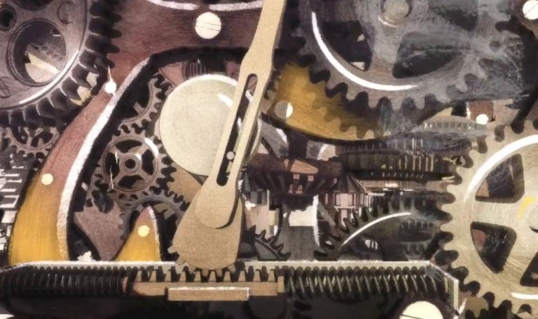
My only contribution to this spot was the still frame of the moustaches. Done in Maya using Maya Fur and Maya Hair.
Not much can bee seen from this distance and grade, but it was really nice hair. Trust me. It was nice.

This was done a relative quick job for the New South Wales government. They had, in fact, recently come back to us for a ‘phase 2’ ad along the same lines, only the deadline was a bit shorter.
The ad was in two parts: the cogs and the town hall scene. I’ll just talk about the cogs scene because that was the only part I was involved in.
I was asked to create the cogs that formed the NSW state lines. We bought a few gears off Turbosquid to get started, but other bits and pieces had to be modelled along the way. I had first set up the layout of the gears, and rigged sections of them to follow different controllers. Then individual gear component combinations were rigged, and then placed into the main scene.
The rendering was also done in LightWave, but the final look was supposed to be hand-drawn. This process was in 3 parts.
The base render was from LW, which was a clean, multi-toned render. LW enables me to colour individual gears/items based on the fact that they are instanced or separated, and I used this to quickly shade variations of the colour theme. I like the fact that I can get lots of shading control across whatever shader channel (eg diffuse, specularity) that I’m using.
After the base render, Richard post-processed that in AE using his own concoction of adjustment layers and textures.
And for the third step, Richard‘s AE renders were passed on to Alexandre Belbari and Thomas Buiron, who gave it the more sketchy, organic look.
When it came back to us, Richard add further effects such as the smoke and particles.
This is a 3-part ad that ran on digital posters. The concept of the ad was simply to use the Japanese origami style of folding. Terry and I worked on this series, with him doing the first two (left and middle), and me doing the third. Terry consolidated all the shading in V-Ray, so that once the rig or animation was complete, they will all, more or less, render the same.
The rigging was, of course, the most complicated bit, along with cutting up the geometry to make it appear to fold. especially in the section I was working on, as it featured lots of round corners, pipe rails, etc. I found it difficult to translate a generator of the design the client wanted to fold like paper. In the end, I wonder if it looked more like a Transformer animation than folding paper.
Iteration is the creative process of improving the work in incremental steps. I don’t know if it’s truly a buzzword, but from where I’m standing, it’s always buzzing around. But I think that iteration means something different depending on where you’re standing.
In an advertising agency, for example, the creative team goes through their own rounds of iteration, brainstorming ideas, solidifying them visually through thumbs for internal meetings, then a concept board (if it’s a TVC) to be cleared with client, then upon feedback, work the process up to a storyboard. The creative process is completely internal in that they have full control over their workflow with the client giving feedback. Ask the creative director what iteration means for her workflow, and she’ll tell you “it’s working up the Idea in small steps, making sure, all the while, the client is kept in the loop and making appropriate feedback, which we then apply, and advance the Idea into a final storyboard to be produced.” So far, so good.
In the post-production shop, the process is pretty much the same, only a bit more complex, naturally; we deal with lots of technical elements. So while an agency might have a single pipeline we have at last four going almost concurrently, and those pipelines intermingle with each other. We have models to be made, rigging to be applied to models, animation to be applied to the rig, models to be shaded, shaded models to be lit, whole scenes to render, renders to be comped, effects to be designed and comped, etc. And that’s a standard bread-and-butter job. Let’s not get into things like simulations, matchmoving, rotoscoping, and the like.
Now imagine the same creative director is working with a post-production shop to produce the TVC. Ask the same question, “What is iteration?” She’ll answer, non-verbatim, with this expectation: “I want to see the final product very soon, and iterate that until it becomes better.”
Because the post-production process is unknown to her, she doesn’t realise that we have many final ‘products’ to iterate over: models have their own iteration-cycle, distinct from the animation iteration-cycle; so is look development, so is effects development; and these come together as a ‘master’ development pipeline with a separate iteration-cycle as well. She doesn’t automatically think to apply her own iterative workflow principle to the post-production side because they are uninformed. But because they prefer not to know, they remain at arm’s length from the post-production group, as distanced as they themselves, as creative teams, are to their clients, who are equally indifferent of their process. The indifference is passed down from client to agency, from agency to post-production, generally speaking.
Now, all this time, I’ve been using the agency’s creative director as my example. This is not a fair emphasis, by the way, though it surely makes the point clear, and many agencies relate this way to post-production houses. But you will also find directors, be it art directors, TVC directors, or anyone calling the ‘creative shots’ are just as guilty of this indifference. But the worse of all, it should be noted, is that the indifference occurs within a post-production group, as some of the upper crust only pay lip-service to the very technical nature of their own operation. Though I began with the ignorance of an agency creative director, she is the least guilty of them all.
The post-production upper crust might have done well to learn the internal creative process of the agency. But I think they condescended to think they could be anything but the client, and thus distancing themselves from their own post-production group. Perhaps by assuming the superior client role, they thought can eke something creative out of the ‘headphone-hooded geeks’.
The agency enjoys a creative process that they themselves have built and enforce in order to serve their own purposes because doing so will yield a better product for the client and for themselves. Yet, the post-production group gets served up onto a plate of uninformed demands by uninformed folks, left undefended by the upper crust who are just as uninformed; and it would have yielded poor results if not for talent and lots unnecessary personal sacrifices. But even sacrifices have their limits.
Anyone who demands, “I want you to go hard out so you can get me the final product tomorrow, so I can iterate/nitpick/pixel-fuck that until it becomes better” does not know what iteration means and lacks the discipline of imagination necessary to mix the creative aesthetic with the highly technical processes, which is what this industry is about.